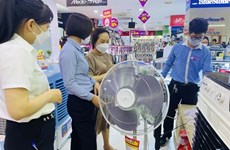Supply chain key to textiles growth
Vietnam can significantly increase export of garment and textiles if
it joins bilateral free trade agreements and multilateral ones like the
Trans-Pacific Partnership, but only if it can set up a robust supply
chain.
Vietnam can significantly increase export of garment and textiles if
it joins bilateral free trade agreements and multilateral ones like the
Trans-Pacific Partnership, but only if it can set up a robust supply
chain.
The problem has dogged the industry for nearly 20 years but remains unresolved despite local firms' efforts to create the chain.
Three-fourths of the country's 3,000 garment and textile companies are domestically owned, but they account for a mere 25 percent of exports.
FDI firms have invested in setting up their own supply chain to take advantage of incentives, resulting in immense value addition for them and profitability.
Garment and textile exports are growing at 18 percent annually, with the foreign sector chalking up 30 percent growth and their local rivals, 8 - 10 percent.
The gap in growth between local and foreign companies is growing wider and wider.
Their limited funding has meant Vietnamese textile and garment firms work mainly as subcontractors.
To become actual producers, local firms must link the supply chain made up mainly of cotton, fibre, textile, dyeing, and apparel.
The textile and dyeing aspects are the weakest points yet and a big hurdle to export efforts.
The Vietnam Garment and Textile Corporation (Vinatex), a leading player, has been investing strongly to develop the supply chain.
In the past each of its factories produced many different items depending on customers' demand, but could not maintain high quality.
"We have decided each fibre factory will focus on one only product and ensure quality," Le Trung Hai, deputy general director of Vinatex, said.
It plans to build a series of plants to make quality products so that it can have its own supply chain and take on new markets.-VNA
The problem has dogged the industry for nearly 20 years but remains unresolved despite local firms' efforts to create the chain.
Three-fourths of the country's 3,000 garment and textile companies are domestically owned, but they account for a mere 25 percent of exports.
FDI firms have invested in setting up their own supply chain to take advantage of incentives, resulting in immense value addition for them and profitability.
Garment and textile exports are growing at 18 percent annually, with the foreign sector chalking up 30 percent growth and their local rivals, 8 - 10 percent.
The gap in growth between local and foreign companies is growing wider and wider.
Their limited funding has meant Vietnamese textile and garment firms work mainly as subcontractors.
To become actual producers, local firms must link the supply chain made up mainly of cotton, fibre, textile, dyeing, and apparel.
The textile and dyeing aspects are the weakest points yet and a big hurdle to export efforts.
The Vietnam Garment and Textile Corporation (Vinatex), a leading player, has been investing strongly to develop the supply chain.
In the past each of its factories produced many different items depending on customers' demand, but could not maintain high quality.
"We have decided each fibre factory will focus on one only product and ensure quality," Le Trung Hai, deputy general director of Vinatex, said.
It plans to build a series of plants to make quality products so that it can have its own supply chain and take on new markets.-VNA












